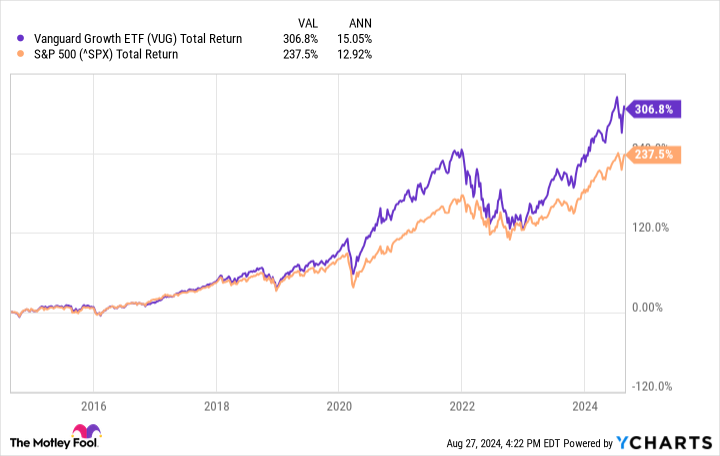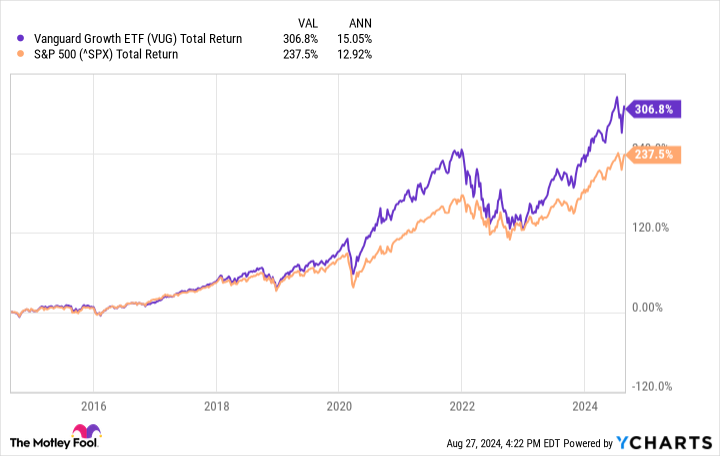The $1 million mark has long been a milestone for financial success. It may not take you as far as it did decades ago, but it’s still a significant achievement worth every celebration it receives. Thankfully, hitting the seven-figure number doesn’t have to be a pipe dream; it can be done using only exchange-traded funds (ETFs).
ETFs allow you to invest in hundreds, and sometimes thousands, of companies with a single investment, greatly simplifying the investing process. For those aiming to hit the $1 million mark, the following two ETFs can help lead the way: The Vanguard S&P 500 ETF (NYSEMKT: VOO) and the Vanguard Growth ETF (NYSEMKT: VUG).
Both ETFs have histories of strong returns and growth prospects that can continue the momentum for decades to come.
1. Vanguard S&P 500 ETF
This ETF mirrors the S&P 500, the stock market’s most followed index (and arguably the most important). The S&P 500 tracks the performance of the 500 largest U.S. companies on the market, giving insight into the health of the broader U.S. economy. They may not be directly correlated, but a strong or weak performance by the S&P 500 generally reflects overall economic strength or weakness.
With this ETF, you’re getting exposure to all major sectors of the U.S. economy:
-
Communication Services: 8.9% of the ETF
-
Consumer Discretionary: 10%
-
Consumer Staples: 5.8%
-
Energy: 3.7%
-
Financials: 13%
-
Health Care: 11.9%
-
Industrials: 8.4%
-
Information Technology: 31.4%
-
Materials: 2.2%
-
Real Estate: 2.3%
-
Utilities: 2.4%
Having an ETF that essentially represents the U.S. economy has proven to be a great long-term investment. Since the S&P 500 became a thing, it has averaged around 10% annual returns over the long run. Since this ETF’s September 2010 inception, it has averaged close to 14.5% annual total returns.
Below is how long it would take to reach $1 million by investing $500 monthly and averaging different annual returns.
|
Average Annual Returns |
Years Until $1 Million |
|---|---|
|
10% |
31 |
|
12% |
27 |
|
14.5% |
24 |
Chart by author. Years rounded to the nearest whole year.
Past returns don’t guarantee future performance, and there’s no way to predict how the ETF will do going forward, but this shows how relatively small monthly investments could pay off long-term with consistency.
2. Vanguard Growth ETF
Like the Vanguard S&P 500 ETF, this ETF focuses on large-cap stocks. The difference is that it only contains companies with strong growth potential, as opposed to those focused on value or dividends.
Large-cap growth stocks can offer investors the best of both worlds. Their size provides a bit more stability than smaller companies with fewer resources, and their growth focus gives investors a chance for market-beating returns (or at least, that’s the intent).
It has proven to be a lucrative two-for-one benefit, with this ETF having outperformed the market in the past decade, averaging over 15% total returns.
This ETF is led by some of the world’s most promising companies. Below are its top 10 holdings and how much of the ETF they make up (as of July 31):
-
Apple: 12.89%
-
Microsoft: 12.39%
-
Nvidia: 10.90%
-
Amazon: 4.87%
-
Meta Platforms: 4.15%
-
Alphabet (Class A): 4.02%
-
Alphabet (Class C): 3.30%
-
Eli Lilly: 2.75%
-
Tesla: 2.52%
-
Visa: 1.63%
The top three holdings make up over 36% of the ETF, which is far from diversified by most standards. However, its top holdings have been some of the most rewarding growth stocks on the market and the catalyst for its market-beating returns. With the emergence of new technologies (artificial intelligence, cloud computing, etc.), healthcare advancements, electric vehicles, and digital payments, these companies should continue on this path.
This ETF shouldn’t be the foundation of your portfolio, but it can be a great complement. If you’re investing in both this ETF and an S&P 500 ETF, it’s important to be mindful of the overlapping companies. You don’t want to become too reliant on too few companies to carry you to the million-dollar mark.
Should you invest $1,000 in Vanguard S&P 500 ETF right now?
Before you buy stock in Vanguard S&P 500 ETF, consider this:
The Motley Fool Stock Advisor analyst team just identified what they believe are the 10 best stocks for investors to buy now… and Vanguard S&P 500 ETF wasn’t one of them. The 10 stocks that made the cut could produce monster returns in the coming years.
Consider when Nvidia made this list on April 15, 2005… if you invested $1,000 at the time of our recommendation, you’d have $731,449!*
Stock Advisor provides investors with an easy-to-follow blueprint for success, including guidance on building a portfolio, regular updates from analysts, and two new stock picks each month. The Stock Advisor service has more than quadrupled the return of S&P 500 since 2002*.
*Stock Advisor returns as of August 26, 2024
Suzanne Frey, an executive at Alphabet, is a member of The Motley Fool’s board of directors. Randi Zuckerberg, a former director of market development and spokeswoman for Facebook and sister to Meta Platforms CEO Mark Zuckerberg, is a member of The Motley Fool’s board of directors. John Mackey, former CEO of Whole Foods Market, an Amazon subsidiary, is a member of The Motley Fool’s board of directors. Stefon Walters has positions in Apple, Microsoft, and Vanguard S&P 500 ETF. The Motley Fool has positions in and recommends Alphabet, Amazon, Apple, Meta Platforms, Microsoft, Nvidia, Tesla, Vanguard Index Funds-Vanguard Growth ETF, Vanguard S&P 500 ETF, and Visa. The Motley Fool recommends the following options: long January 2026 $395 calls on Microsoft and short January 2026 $405 calls on Microsoft. The Motley Fool has a disclosure policy.
Want $1 Million in Retirement? 2 ETFs to Buy Now and Hold for Decades was originally published by The Motley Fool
EMEA Tribune is not involved in this news article, it is taken from our partners and or from the News Agencies. Copyright and Credit go to the News Agencies, email news@emeatribune.com Follow our WhatsApp verified Channel






